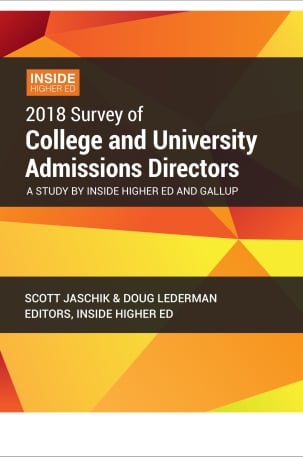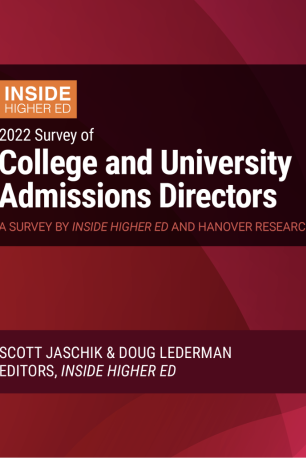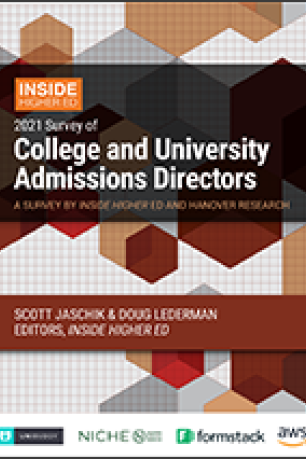Free Download

Not only are a majority of colleges failing to fill their new classes by May 1, the traditional target date, but they are failing to do so by June 1 as well, according to the 2018 Survey of College and University Admissions Directors, released today by Inside Higher Ed, in collaboration with Gallup.
The survey is based on responses from 499 people who are the senior person in admissions or enrollment management at their institutions. Admissions directors were given complete anonymity, but their institutions were tracked to allow for sorting by sector. This year's survey shows continued pressure on colleges -- in an era when missing enrollment targets can be devastating to institutional finances -- to enroll a class that meets their goals.
About the Survey
Inside Higher Ed's 2018 Survey of College and University Admissions Directors was conducted in conjunction with researchers from Gallup. Inside Higher Ed regularly surveys key higher ed professionals on a range of topics.
You may download a full survey report here.
You may download the full report on the survey of counselors (conducted with Hanover Research) here.
On Thursday, Oct. 25, at 2 p.m. Eastern, Inside Higher Ed will present a free webcast to discuss the results of the surveys. Sign up here.
The Inside Higher Ed survey of admissions directors was made possible in part by support from Salesforce, the American Association of Collegiate Registrars and Admissions Officers, and the Educational Testing Service.
Among other key findings:
- Many college admissions leaders believe that the recent decision by the University of Chicago to end its SAT/ACT requirement will prompt other colleges to follow suit. And a majority believe that the emphasis on testing in admissions discussions discourages students from considering colleges where they could be admitted and thrive.
- A majority of college admissions leaders do not value the writing tests on either the SAT or the ACT and believe that better ways exist to evaluate the writing skills of applicants.
- Almost half of college admissions directors said they believe some colleges hold Asian American applicants to higher standards for admission than they hold other applicants.
- Thirty-nine percent of admissions directors said that, at their college, Asian American applicants who are admitted have higher grades and test scores than do other admitted applicants.
- More than two-thirds of colleges admit less than 5 percent of their students from waiting lists -- even at a time when college waiting lists seem to be growing. Most admissions directors believe that waiting lists are too long.
- Many college admissions leaders worry about their ability to enroll international students at the same levels as in the past.
- College admissions leaders see rigor in Advanced Placement courses but worry that students feel pressure to take too many of them. (See related article.)
- Most college admissions directors are satisfied with their customer relationship manager systems, but they don't have as much confidence in their social media strategies.
This year, Inside Higher Ed together with Hanover Research also conducted a survey of high school counselors, who in some cases agree with -- and others do not agree with -- the views of college admissions directors. Many of the topics covered here will also be featured at the annual meeting of the National Association for College Admission Counseling, convening this week in Salt Lake City.
Filling the Class
 Historically, May 1 has been the date by which admitted applicants reply to admissions offers and colleges have aimed to have their classes filled. This date has never been the norm for community colleges and some open-enrollment institutions, but until recently, it was the key date for knowing the size of the incoming class. In recent years, increasing numbers of colleges -- including colleges that once cared deeply about the May 1 goal -- have failed to fill classes by May 1, and many now say that June 1 or July 1 are more significant dates.
Historically, May 1 has been the date by which admitted applicants reply to admissions offers and colleges have aimed to have their classes filled. This date has never been the norm for community colleges and some open-enrollment institutions, but until recently, it was the key date for knowing the size of the incoming class. In recent years, increasing numbers of colleges -- including colleges that once cared deeply about the May 1 goal -- have failed to fill classes by May 1, and many now say that June 1 or July 1 are more significant dates.
Inside Higher Ed has for several years asked about meeting the May 1 deadline. This year (hat tip for the suggestion to attendees at last year's NACAC meeting) Inside Higher Ed also asked about June 1.
May 1 continues to be an unattainable goal for most colleges. Only 38 percent of colleges this year reported that they had met their goals by that date. While that figure is up from last year's figure of 34 percent, this is the third year in a row that the figure is less than 40 percent. (Four years ago, it was 42 percent).
The only sector of higher education this year where a majority of admissions directors reported meeting or exceeding targets by May 1 was public doctoral institutions, which in recent years have seen booms in applications. Indeed, many smaller private colleges report increased competition from public flagships, many of which have created honors programs in recent years to offer some of the more personal educational experiences offered by liberal arts colleges.
Adding in the June 1 deadline, most colleges remain below their goals for the year, suggesting that recruitment for the current academic year extended well into the summer.
Meeting Admissions Goals
| Public doctoral | Public master's/bachelor's | Community college | Private doctoral/master's | Private bachelor's | |
| Met goal by May 1 | 54% | 27% | 26% | 47% | 43% |
| Didn't meet May 1, but met by June 1 | 2% | 10% | 8% | 6% | 7% |
College admissions directors, as in recent years, continue to report a great deal of concern about meeting their enrollment goals, with public doctoral institutions being the exception. While there is widespread publicity every year about elite colleges and their record high application levels and record low admit rates, these figures show the reality of admissions work: primarily it is about recruiting and enrolling a class, not just rejecting people. Not a single admissions director at a community college or bachelor's-granting private college reported not being concerned at all about filling the class.
High Anxiety About Filling Classes
| Public doctoral | Public master's/bachelor's | Community college | Private doctoral/master's | Private bachelor's | |
| % very concerned | 24% | 62% | 54% | 53% | 53% |
| % moderately concerned | 54% | 27% | 28% | 30% | 35% |
| % not too concerned | 16% | 7% | 8% | 11% | 6% |
| % not concerned at all | 6% | 4% | 0% | 6% | 0% |
Standards for Asian American Applications
Recent months have seen renewed national debate about the consideration of race and ethnicity (and other factors) in college admissions. A lawsuit against Harvard University alleges that its admissions policies, which consider the race and ethnicity of applicants, result in discrimination against Asian American applicants. The U.S. Justice Department is backing the suit. The suit has also focused attention on the way many colleges, such as Harvard, favor applicants who are athletes or the children of alumni. While those policies are not being challenged in the lawsuit, data from Harvard indicate that the paucity of Asian Americans in those groups is a key explanation for the lower admit rates for Asian American applicants, compared to white applicants.
Harvard admissions are über-competitive in a way that is atypical for higher education. But many colleges consider race and ethnicity in admissions, and many more consider race and ethnicity for some scholarships or for some summer programs. As a result, many supporters of affirmative action are concerned that the lawsuit against Harvard is intended -- once it reaches appeals courts -- to seek broad limits on how colleges consider race and ethnicity. The retirement of Supreme Court justice Anthony M. Kennedy -- a key vote for affirmative action, within certain limits -- has many college leaders particularly concerned.
 One subject of public debate in the Harvard case has been whether Asian American applicants have to get over a higher bar to be admitted than do other applicants. Many admissions leaders believe this to be true.
One subject of public debate in the Harvard case has been whether Asian American applicants have to get over a higher bar to be admitted than do other applicants. Many admissions leaders believe this to be true.
Almost half of college admissions directors (46 percent) said that they believe some colleges hold Asian American applicants to higher standards for admission than other applicants.
Thirty-nine percent of admissions directors said that, at their college, Asian American applicants who are admitted have higher grades and test scores than do other admitted applicants. The numbers were highest at public doctoral institutions (47 percent) and public master's/bachelor's institutions (46 percent).
Inside Higher Ed asked similar questions of high school counselors. Asked if Asian American students at their high school appear to need better academic credentials than other students to get into competitive colleges, 43 percent of respondents agreed while 36 percent disagreed. Similarly, when asked if they think that Asian American students at their school believe that the admissions system discriminates against them, 37 percent of respondents agreed while 40 percent disagreed.
It is important to note that, even if the average grades and test scores of Asian students at a given college are higher than those of other students, that does not prove discrimination. The Supreme Court has (multiple times) upheld the use of holistic admissions, in which colleges evaluate each applicant as an individual, including a wide range of factors, in some cases including race and ethnicity. However, the gaps in grades and test scores may matter in that the Supreme Court has also warned against admissions practices that effectively create two-tiered approaches to considering applicants from various groups.
Answers to other questions in the survey illustrate the challenges the Harvard lawsuit and resulting attention pose to higher education -- regardless of the outcome of the litigation.
- Almost half (49 percent) of admissions directors say that the Harvard lawsuit "has created significant distrust among Asian American applicants and their families" in the admissions process. At public doctoral institutions, the figure is 53 percent. At private doctoral/master's institutions, the figure is 60 percent.
- Half of admissions directors are concerned that the suit against Harvard will lead to broader attacks on affirmative action in higher education.
- At a time when Harvard's defense rests on its right to practice holistic admissions, more than three-fourths of admissions directors say that the public does not understand the concept of holistic admissions.
What About Legacies?
The Harvard case has renewed attention on the policies of many colleges (primarily but not exclusively private institutions) of considering legacy status (in other words if the applicant is related to a graduate) in admissions. In the 1980s, some Asian American groups charged that Harvard's legacy preferences (which overwhelmingly favor white people) were a form of discrimination, but the Education Department's Office for Civil Rights in 1990 found that these preferences were motivated by legitimate, non-bias-related reasons and were legal. But even if legal, are they appropriate?
 Generally, college leaders defend these preferences as a way to keep alumni engaged (and giving money), and to create a multigenerational spirit about an institution, while critics decry what they see as "silver spoon" admissions. While college leaders regularly defend affirmative action in public statements, relatively few speak out about legacy admissions.
Generally, college leaders defend these preferences as a way to keep alumni engaged (and giving money), and to create a multigenerational spirit about an institution, while critics decry what they see as "silver spoon" admissions. While college leaders regularly defend affirmative action in public statements, relatively few speak out about legacy admissions.
Forty-two percent of admissions directors at private colleges and universities said that legacy status is a factor in admissions decisions at their institutions. The figure at public institutions is only 6 percent. (In some cases, the preference at public institutions is to grant alumni children in-state status even if they are from out of state, and that can make a significant difference in a candidate's odds of admission.)
Only a minority of admissions directors believe that legacy status is an appropriate admissions consideration. Among admissions directors at private institutions, the figure is 32 percent. At public institutions, the figure is 16 percent. Eleven percent of admissions directors at colleges that do consider legacy status do not consider it appropriate to do so.
Generally, when college admissions leaders talk about legacy status, they stress that legacy applicants tend to be strong applicants regardless. And generally, it is true that those whose parents went to college (anywhere) are more likely than other students to go to good high schools and have a range of educational opportunities.
High school counselors tend to think that legacy status makes a difference. Sixty-five percent say that students at their high school who have legacy status appear to have much better chances of admission than do other students applying to competitive colleges. However, only 44 percent of respondents agree that legacy status is a reasonable factor in college admissions.
Going Test Optional
Hundreds of colleges over the years have dropped requirements that applicants submit SAT or ACT scores. Many of those colleges are not competitive in admissions, but a growing number are. The June announcement by the University of Chicago that it was going test optional drew much more attention than announcements from other institutions because of Chicago's reputation for academic rigor.
that it was going test optional drew much more attention than announcements from other institutions because of Chicago's reputation for academic rigor.
Further, the announcement came at a time when many admissions leaders believe that reliance on tests (on which black and Latino students, on average, have lower scores than do white and Asian students) could make it more difficult to preserve diversity if new limits are imposed on affirmative action.
Admissions directors believe the decision by Chicago will have an influence on other institutions. A majority (56 percent) said they thought the move would influence other colleges to follow suit.
Seventeen percent of admissions directors said that Chicago's decision was prompting their institution to reconsider its testing requirements. The figure was 22 percent at public doctoral institutions and private baccalaureate institutions.
Many admissions leaders also see a damaging impact of the way score averages are talked about. A large majority (62 percent) said they believed that the way many parents and prospective students refer to average test scores at various colleges "discourage[s] many students from applying to colleges where they could be admitted and thrive."
Most high school counselors would also be happy to see a move away from standardized testing requirements. A solid majority (59 percent) said they wished all colleges went test optional.
Counselors said that test-optional policies are of particular interest to some groups of students. Counselors said that, of students who are aware of test-optional colleges, 64 percent of those who are minority students like the option, and 58 percent of disadvantaged students do.
The counselors' survey, however, also pointed to a communication issue. Only about half of counselors said that they think students at their high school are aware of which colleges are test optional.
The SAT/ACT Essay
 One part of the SAT and ACT has drawn particular criticism in the last year: the essay.
One part of the SAT and ACT has drawn particular criticism in the last year: the essay.
The College Board first started offering an essay on the SAT in 2005. But many writing experts were highly critical of the format, noting among other things that it did not judge whether statements were factually correct. Les Perelman, an MIT writing professor, famously coached students on how to write ludicrous essays that would receive high scores.
In 2014, the College Board announced revisions to the SAT -- with substantial changes to the essay, including the use of writing passages to force test takers to cite evidence for opinions in their essays. Some advocates for the essay hoped the changes would lead more colleges to rely on it as part of the admissions process.
While many critics of the first SAT essay have said that the revisions improved it, few have valued it. Harvard in March announced it would no longer require the essay, and a number of other elite colleges followed, leaving only a handful requiring the essay (even though most students taking the SAT continue to prepare for it and to take it). Many who teach writing have been urging that the essay to be eliminated.
Few college admissions directors see the essays on the SAT or ACT helping their work.
Only 12 percent said they gain insights on applicants from the SAT essay. The figure was only slightly higher (13 percent) for the ACT essay.
Thee-quarters (75 percent) of admissions directors said that the essay portions of the SAT and ACT should be dropped.
As colleges have dropped the essay requirements, admissions leaders have stressed that they care deeply about the writing skills of applicants and plan other ways to evaluate those skills.
One idea being embraced by some colleges and studied by others is to require applicants to submit a graded high school paper. A majority (51 percent) of admissions directors said they believed this would provide more insights than the scores on the SAT or ACT essay.
Are Waiting Lists Out of Control?
![]() Rejections are of course part of the admissions process -- and students have for generations been getting over being turned down by one college only to go on to get great educations somewhere else. But a trend in recent years has annoyed many educators.
Rejections are of course part of the admissions process -- and students have for generations been getting over being turned down by one college only to go on to get great educations somewhere else. But a trend in recent years has annoyed many educators.
Some colleges are expanding waiting lists such that they have a greater number of names than will be enrolled in the entire first-year class. In many cases, such colleges admit few if any from the waiting list, meaning applicants continue to pine for one college rather than getting excited about another.
For the first time this year, Inside Higher Ed asked college admissions directors how often they used their waiting lists to admit students. For most institutions, the numbers are small.
Asked for the share of first-year students who have been admitted off the waiting list in recent years, 15 percent said that they hadn't admitted anyone that way. More than two-thirds (68 percent) said they admitted some students but less than 5 percent of their class. Only 17 percent said that they admitted more than 5 percent that way.
A majority of college admissions directors (61 percent) said that they agreed that waiting lists are too long.
One theory about the growth of waiting lists is that colleges want to avoid outright rejecting applicants who have family or other connections to an institution. Fifteen percent of admissions directors said this was a factor.
Counselors also see problems with long waiting lists. Forty-six percent said that applicants would be better served by being rejected than placed on waiting lists. And 46 percent also said that only "rarely" does a student from their high school end up being admitted off a waiting list.
Concerns About International Enrollments
For at least a decade, many colleges -- including some in the past that focused international student recruitment on graduate and professional education -- have placed a high priority on recruiting international undergraduates. Colleges have been motivated by a mix of educational values (seeing such students adding perspectives to the student body) and practical considerations (many of those recruited are "full pay," helping colleges balance budgets).
 For many college leaders, the events of the last year have raised concerns about their international student strategies. Last fall, American colleges and universities reported a 7 percent decline in new international enrollments.
For many college leaders, the events of the last year have raised concerns about their international student strategies. Last fall, American colleges and universities reported a 7 percent decline in new international enrollments.
To admissions directors, there isn't much doubt about the reasons for the decline. Nearly three-fourths (74 percent) said that the "policies and rhetoric" of the Trump administration have made it more difficult to recruit international students.
And 57 percent said that they are concerned about maintaining current levels of international enrollment.
Many college admissions leaders said that they are considering new policies to attract more international students:
- 57 percent said that pathways programs (in which international students enroll in programs to improve their English before gaining full admission to colleges) will become more important in the years ahead.
- 42 percent said that their college would need to consider increased spending on scholarships for international students. This runs counter to the view that colleges can continue to focus on full-pay international students.
- 39 percent said they believe that the current environment will prompt more colleges to use international recruiting agents who are paid in part on commission.
Recruiting Strategies
Colleges invest in customer relationship management (CRM) systems as part of their strategies for recruiting students.
A majority of colleges are satisfied with their CRM systems (although plenty are not). The following table shows college admissions directors' satisfaction with elements of their recruiting strategy. There are some differences based on the level of centralization of admissions operations. Generally, officials were more satisfied with their CRM than they were with their social media strategy.
Satisfaction With Services
| One main college | Multiple divisions, centralized admissions office | Multiple divisions, multiple admissions offices | |
| % satisfied with CRM | 71% | 65% | 73% |
| % satisfied with marketing strategy | 61% | 66% | 65% |
| % satisfied with social media strategy | 47% | 63% | 55% |







